An Economic Analysis of Monopoly, Oligopoly, and Duopoly in Australia
VerifiedAdded on 2020/03/02
|6
|1528
|76
Report
AI Summary
This report provides a comprehensive analysis of monopoly, oligopoly, and duopoly market structures within the Australian economy. It begins with an introduction to basic economic concepts, differentiating between microeconomics and macroeconomics, and then delves into the specifics of each market structure. The report examines the characteristics, examples, and impacts of monopolies (e.g., Australian Post), oligopolies (e.g., Coles and Woolworths), and duopolies (e.g., Sonic Health and Primary Health Care) in the Australian context. It includes graphical representations of profit maximization in monopoly and oligopoly markets, referencing key economic models. Furthermore, the report offers recommendations on how to improve market competition, advocating for policies that encourage more firms to enter the market and reduce restrictions. The conclusion emphasizes the importance of competitive markets for economic growth, job creation, and consumer benefits. Finally, it includes a detailed bibliography of the resources used in the analysis.
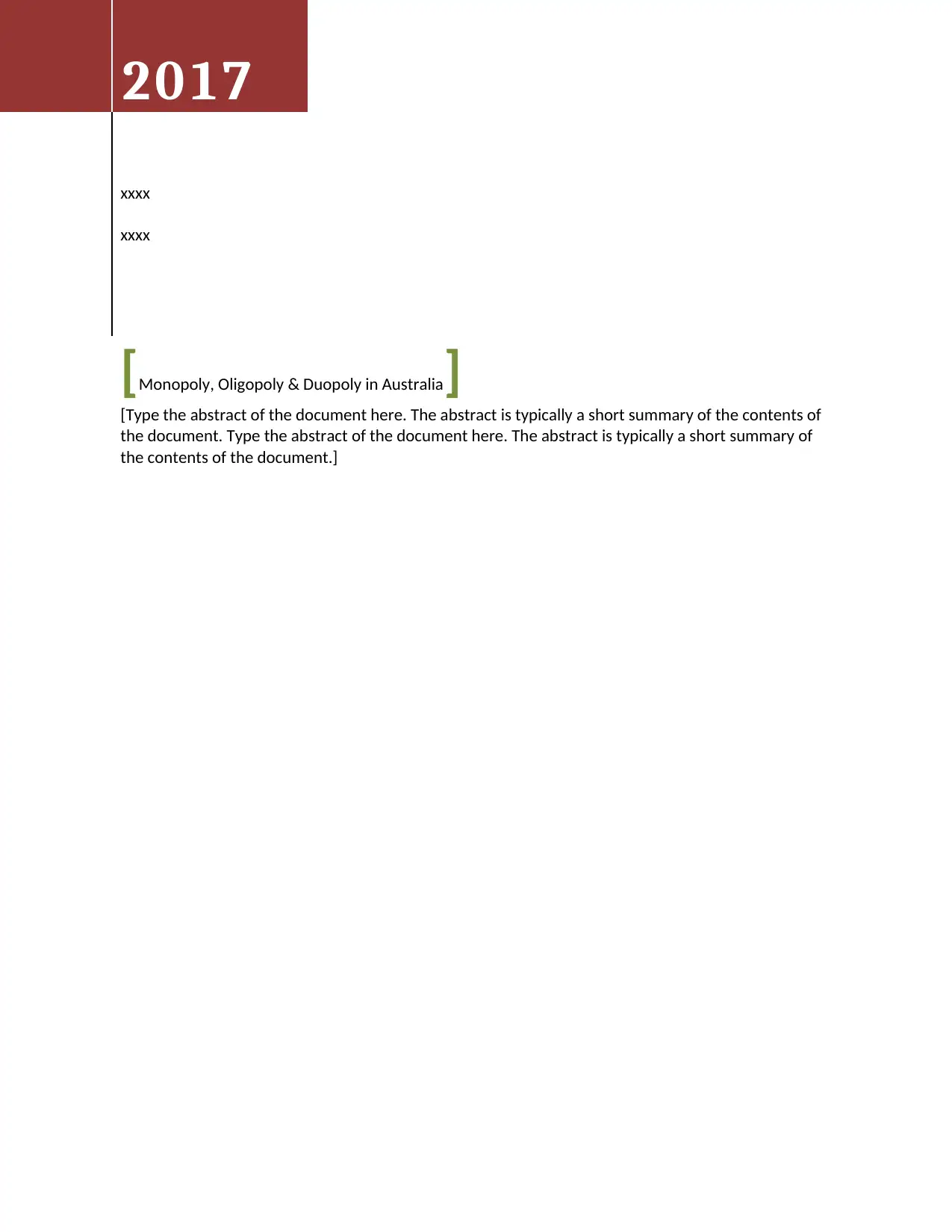
[Monopoly, Oligopoly & Duopoly in Australia]
[Type the abstract of the document here. The abstract is typically a short summary of the contents of
the document. Type the abstract of the document here. The abstract is typically a short summary of
the contents of the document.]
2017
xxxx
xxxx
[Type the abstract of the document here. The abstract is typically a short summary of the contents of
the document. Type the abstract of the document here. The abstract is typically a short summary of
the contents of the document.]
2017
xxxx
xxxx
Paraphrase This Document
Need a fresh take? Get an instant paraphrase of this document with our AI Paraphraser
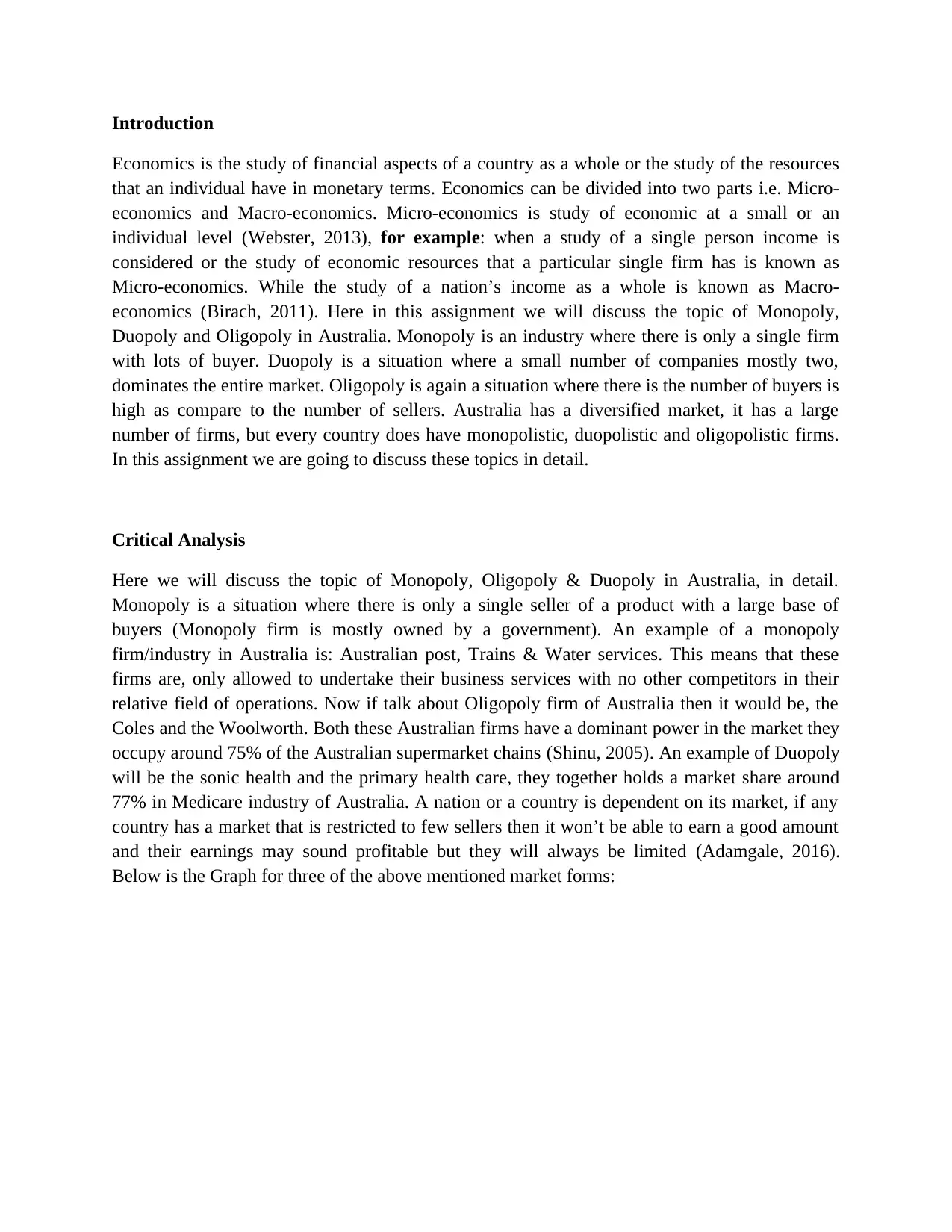
Introduction
Economics is the study of financial aspects of a country as a whole or the study of the resources
that an individual have in monetary terms. Economics can be divided into two parts i.e. Micro-
economics and Macro-economics. Micro-economics is study of economic at a small or an
individual level (Webster, 2013), for example: when a study of a single person income is
considered or the study of economic resources that a particular single firm has is known as
Micro-economics. While the study of a nation’s income as a whole is known as Macro-
economics (Birach, 2011). Here in this assignment we will discuss the topic of Monopoly,
Duopoly and Oligopoly in Australia. Monopoly is an industry where there is only a single firm
with lots of buyer. Duopoly is a situation where a small number of companies mostly two,
dominates the entire market. Oligopoly is again a situation where there is the number of buyers is
high as compare to the number of sellers. Australia has a diversified market, it has a large
number of firms, but every country does have monopolistic, duopolistic and oligopolistic firms.
In this assignment we are going to discuss these topics in detail.
Critical Analysis
Here we will discuss the topic of Monopoly, Oligopoly & Duopoly in Australia, in detail.
Monopoly is a situation where there is only a single seller of a product with a large base of
buyers (Monopoly firm is mostly owned by a government). An example of a monopoly
firm/industry in Australia is: Australian post, Trains & Water services. This means that these
firms are, only allowed to undertake their business services with no other competitors in their
relative field of operations. Now if talk about Oligopoly firm of Australia then it would be, the
Coles and the Woolworth. Both these Australian firms have a dominant power in the market they
occupy around 75% of the Australian supermarket chains (Shinu, 2005). An example of Duopoly
will be the sonic health and the primary health care, they together holds a market share around
77% in Medicare industry of Australia. A nation or a country is dependent on its market, if any
country has a market that is restricted to few sellers then it won’t be able to earn a good amount
and their earnings may sound profitable but they will always be limited (Adamgale, 2016).
Below is the Graph for three of the above mentioned market forms:
Economics is the study of financial aspects of a country as a whole or the study of the resources
that an individual have in monetary terms. Economics can be divided into two parts i.e. Micro-
economics and Macro-economics. Micro-economics is study of economic at a small or an
individual level (Webster, 2013), for example: when a study of a single person income is
considered or the study of economic resources that a particular single firm has is known as
Micro-economics. While the study of a nation’s income as a whole is known as Macro-
economics (Birach, 2011). Here in this assignment we will discuss the topic of Monopoly,
Duopoly and Oligopoly in Australia. Monopoly is an industry where there is only a single firm
with lots of buyer. Duopoly is a situation where a small number of companies mostly two,
dominates the entire market. Oligopoly is again a situation where there is the number of buyers is
high as compare to the number of sellers. Australia has a diversified market, it has a large
number of firms, but every country does have monopolistic, duopolistic and oligopolistic firms.
In this assignment we are going to discuss these topics in detail.
Critical Analysis
Here we will discuss the topic of Monopoly, Oligopoly & Duopoly in Australia, in detail.
Monopoly is a situation where there is only a single seller of a product with a large base of
buyers (Monopoly firm is mostly owned by a government). An example of a monopoly
firm/industry in Australia is: Australian post, Trains & Water services. This means that these
firms are, only allowed to undertake their business services with no other competitors in their
relative field of operations. Now if talk about Oligopoly firm of Australia then it would be, the
Coles and the Woolworth. Both these Australian firms have a dominant power in the market they
occupy around 75% of the Australian supermarket chains (Shinu, 2005). An example of Duopoly
will be the sonic health and the primary health care, they together holds a market share around
77% in Medicare industry of Australia. A nation or a country is dependent on its market, if any
country has a market that is restricted to few sellers then it won’t be able to earn a good amount
and their earnings may sound profitable but they will always be limited (Adamgale, 2016).
Below is the Graph for three of the above mentioned market forms:
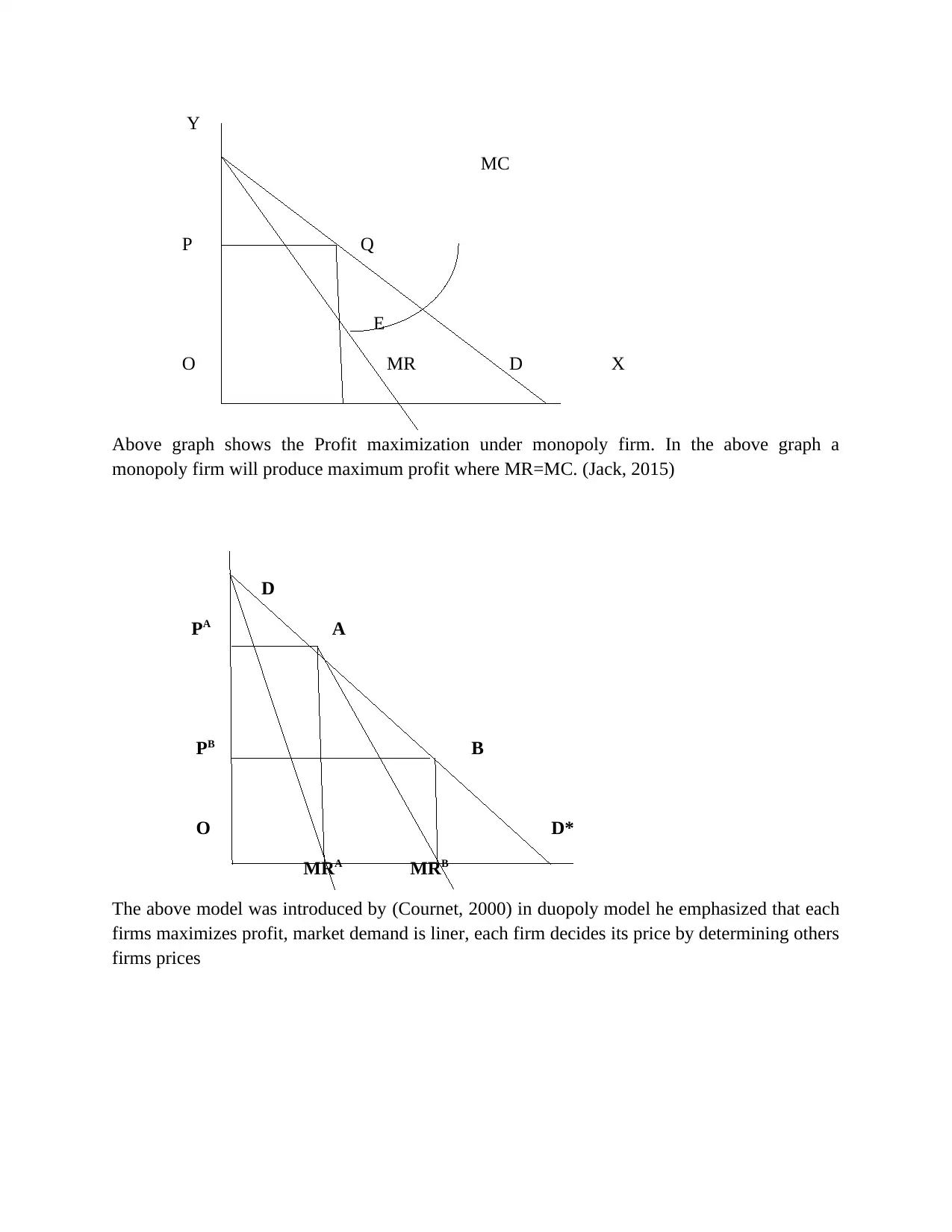
Y
MC
P Q
E
O MR D X
Above graph shows the Profit maximization under monopoly firm. In the above graph a
monopoly firm will produce maximum profit where MR=MC. (Jack, 2015)
D
PA A
PB B
O D*
MRA MRB
The above model was introduced by (Cournet, 2000) in duopoly model he emphasized that each
firms maximizes profit, market demand is liner, each firm decides its price by determining others
firms prices
MC
P Q
E
O MR D X
Above graph shows the Profit maximization under monopoly firm. In the above graph a
monopoly firm will produce maximum profit where MR=MC. (Jack, 2015)
D
PA A
PB B
O D*
MRA MRB
The above model was introduced by (Cournet, 2000) in duopoly model he emphasized that each
firms maximizes profit, market demand is liner, each firm decides its price by determining others
firms prices
⊘ This is a preview!⊘
Do you want full access?
Subscribe today to unlock all pages.

Trusted by 1+ million students worldwide
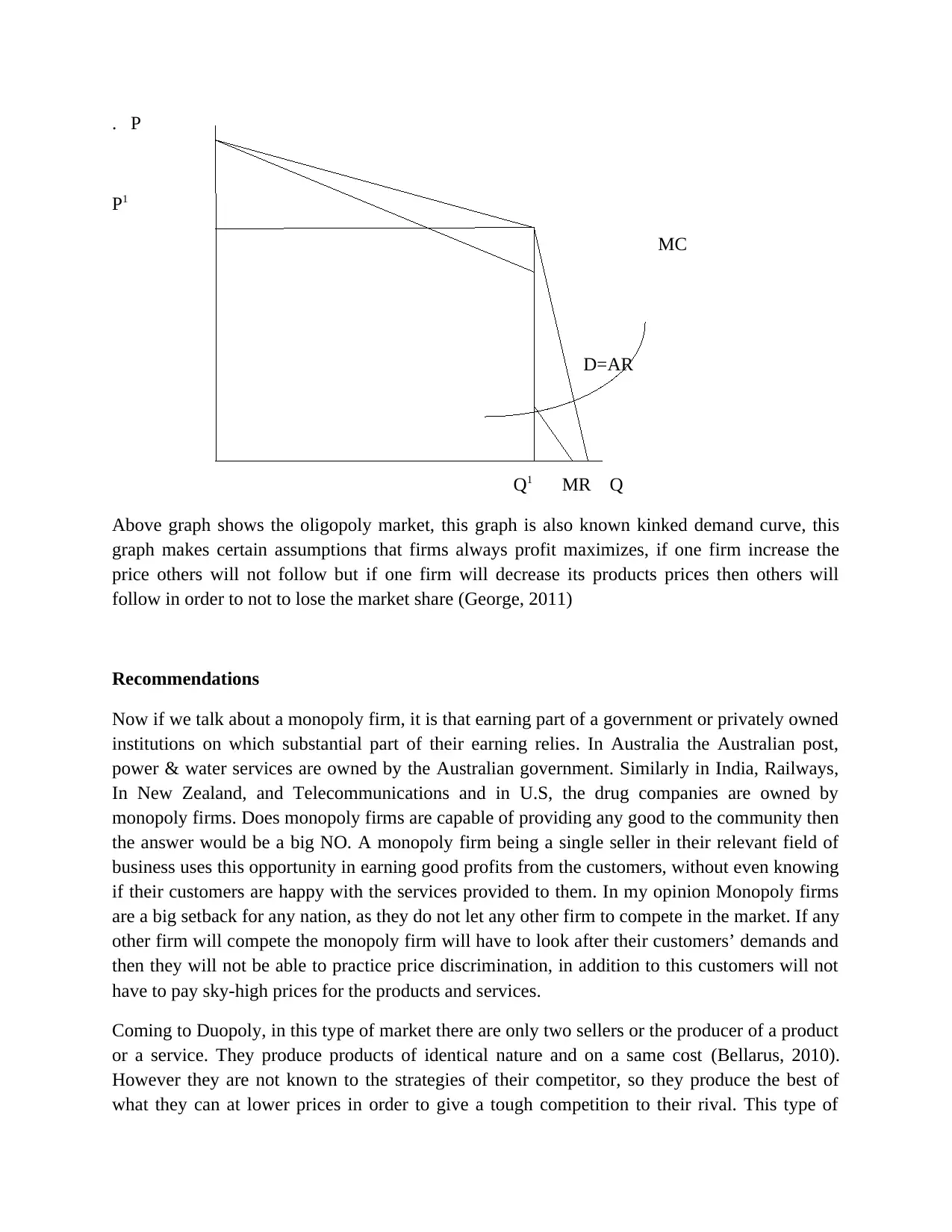
. P
P1
MC
D=AR
Q1 MR Q
Above graph shows the oligopoly market, this graph is also known kinked demand curve, this
graph makes certain assumptions that firms always profit maximizes, if one firm increase the
price others will not follow but if one firm will decrease its products prices then others will
follow in order to not to lose the market share (George, 2011)
Recommendations
Now if we talk about a monopoly firm, it is that earning part of a government or privately owned
institutions on which substantial part of their earning relies. In Australia the Australian post,
power & water services are owned by the Australian government. Similarly in India, Railways,
In New Zealand, and Telecommunications and in U.S, the drug companies are owned by
monopoly firms. Does monopoly firms are capable of providing any good to the community then
the answer would be a big NO. A monopoly firm being a single seller in their relevant field of
business uses this opportunity in earning good profits from the customers, without even knowing
if their customers are happy with the services provided to them. In my opinion Monopoly firms
are a big setback for any nation, as they do not let any other firm to compete in the market. If any
other firm will compete the monopoly firm will have to look after their customers’ demands and
then they will not be able to practice price discrimination, in addition to this customers will not
have to pay sky-high prices for the products and services.
Coming to Duopoly, in this type of market there are only two sellers or the producer of a product
or a service. They produce products of identical nature and on a same cost (Bellarus, 2010).
However they are not known to the strategies of their competitor, so they produce the best of
what they can at lower prices in order to give a tough competition to their rival. This type of
P1
MC
D=AR
Q1 MR Q
Above graph shows the oligopoly market, this graph is also known kinked demand curve, this
graph makes certain assumptions that firms always profit maximizes, if one firm increase the
price others will not follow but if one firm will decrease its products prices then others will
follow in order to not to lose the market share (George, 2011)
Recommendations
Now if we talk about a monopoly firm, it is that earning part of a government or privately owned
institutions on which substantial part of their earning relies. In Australia the Australian post,
power & water services are owned by the Australian government. Similarly in India, Railways,
In New Zealand, and Telecommunications and in U.S, the drug companies are owned by
monopoly firms. Does monopoly firms are capable of providing any good to the community then
the answer would be a big NO. A monopoly firm being a single seller in their relevant field of
business uses this opportunity in earning good profits from the customers, without even knowing
if their customers are happy with the services provided to them. In my opinion Monopoly firms
are a big setback for any nation, as they do not let any other firm to compete in the market. If any
other firm will compete the monopoly firm will have to look after their customers’ demands and
then they will not be able to practice price discrimination, in addition to this customers will not
have to pay sky-high prices for the products and services.
Coming to Duopoly, in this type of market there are only two sellers or the producer of a product
or a service. They produce products of identical nature and on a same cost (Bellarus, 2010).
However they are not known to the strategies of their competitor, so they produce the best of
what they can at lower prices in order to give a tough competition to their rival. This type of
Paraphrase This Document
Need a fresh take? Get an instant paraphrase of this document with our AI Paraphraser
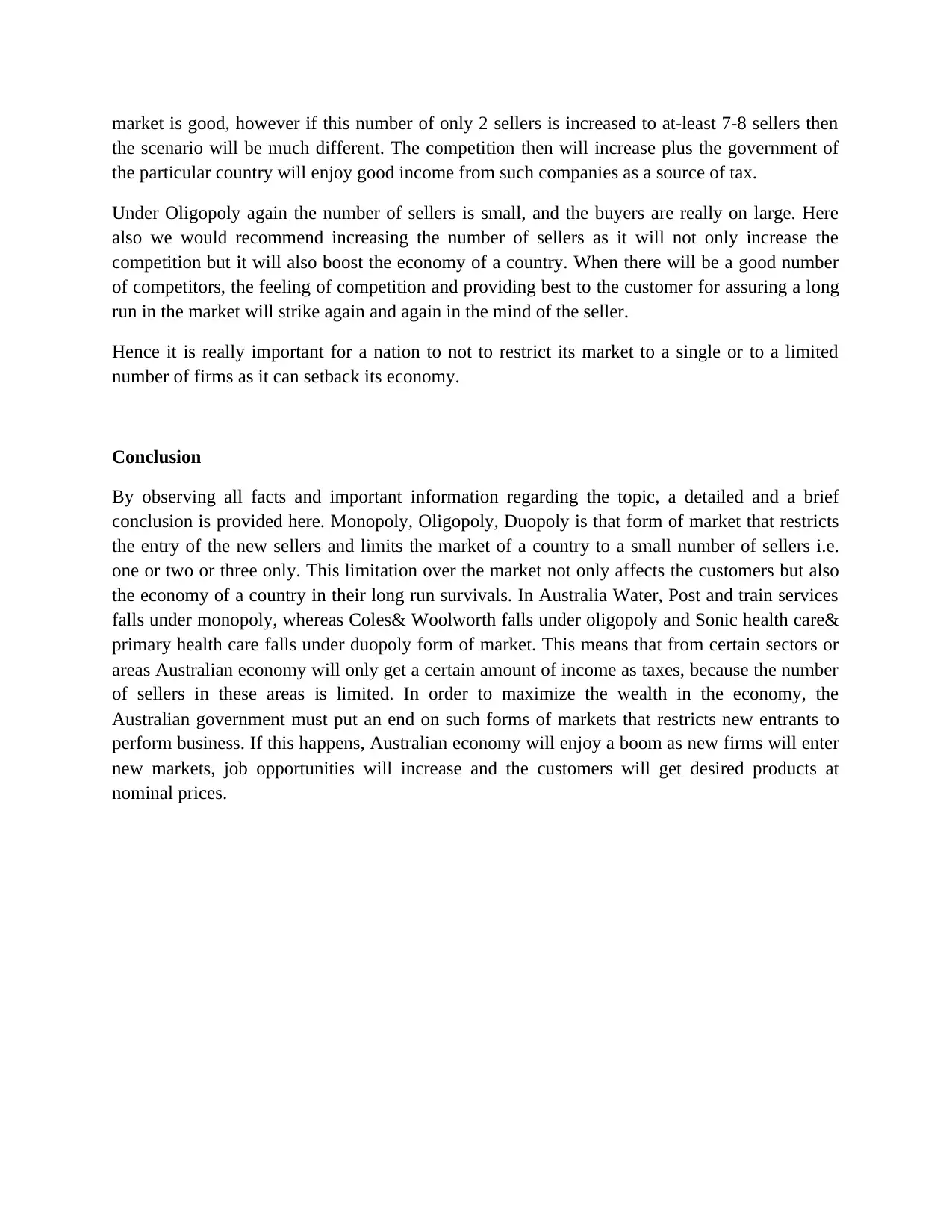
market is good, however if this number of only 2 sellers is increased to at-least 7-8 sellers then
the scenario will be much different. The competition then will increase plus the government of
the particular country will enjoy good income from such companies as a source of tax.
Under Oligopoly again the number of sellers is small, and the buyers are really on large. Here
also we would recommend increasing the number of sellers as it will not only increase the
competition but it will also boost the economy of a country. When there will be a good number
of competitors, the feeling of competition and providing best to the customer for assuring a long
run in the market will strike again and again in the mind of the seller.
Hence it is really important for a nation to not to restrict its market to a single or to a limited
number of firms as it can setback its economy.
Conclusion
By observing all facts and important information regarding the topic, a detailed and a brief
conclusion is provided here. Monopoly, Oligopoly, Duopoly is that form of market that restricts
the entry of the new sellers and limits the market of a country to a small number of sellers i.e.
one or two or three only. This limitation over the market not only affects the customers but also
the economy of a country in their long run survivals. In Australia Water, Post and train services
falls under monopoly, whereas Coles& Woolworth falls under oligopoly and Sonic health care&
primary health care falls under duopoly form of market. This means that from certain sectors or
areas Australian economy will only get a certain amount of income as taxes, because the number
of sellers in these areas is limited. In order to maximize the wealth in the economy, the
Australian government must put an end on such forms of markets that restricts new entrants to
perform business. If this happens, Australian economy will enjoy a boom as new firms will enter
new markets, job opportunities will increase and the customers will get desired products at
nominal prices.
the scenario will be much different. The competition then will increase plus the government of
the particular country will enjoy good income from such companies as a source of tax.
Under Oligopoly again the number of sellers is small, and the buyers are really on large. Here
also we would recommend increasing the number of sellers as it will not only increase the
competition but it will also boost the economy of a country. When there will be a good number
of competitors, the feeling of competition and providing best to the customer for assuring a long
run in the market will strike again and again in the mind of the seller.
Hence it is really important for a nation to not to restrict its market to a single or to a limited
number of firms as it can setback its economy.
Conclusion
By observing all facts and important information regarding the topic, a detailed and a brief
conclusion is provided here. Monopoly, Oligopoly, Duopoly is that form of market that restricts
the entry of the new sellers and limits the market of a country to a small number of sellers i.e.
one or two or three only. This limitation over the market not only affects the customers but also
the economy of a country in their long run survivals. In Australia Water, Post and train services
falls under monopoly, whereas Coles& Woolworth falls under oligopoly and Sonic health care&
primary health care falls under duopoly form of market. This means that from certain sectors or
areas Australian economy will only get a certain amount of income as taxes, because the number
of sellers in these areas is limited. In order to maximize the wealth in the economy, the
Australian government must put an end on such forms of markets that restricts new entrants to
perform business. If this happens, Australian economy will enjoy a boom as new firms will enter
new markets, job opportunities will increase and the customers will get desired products at
nominal prices.
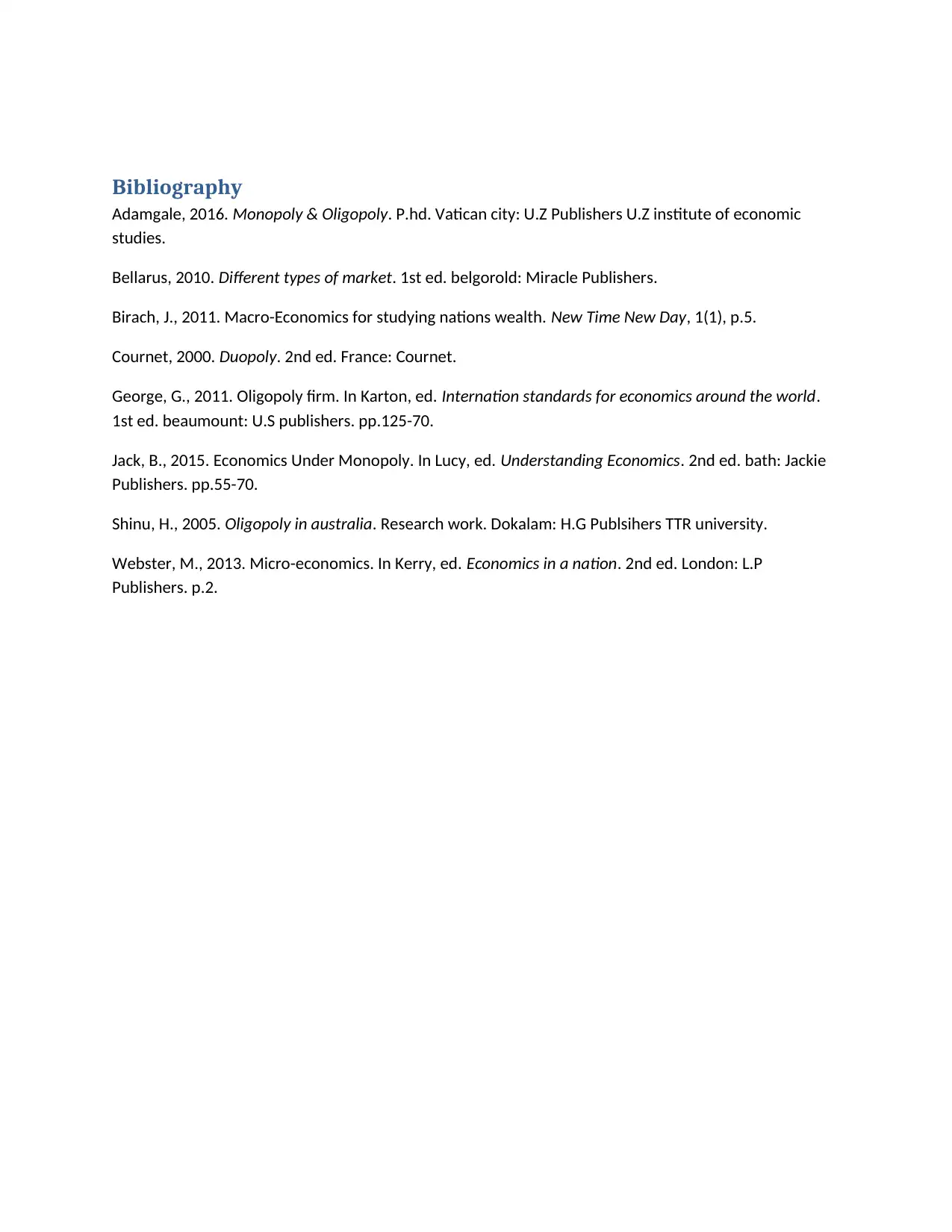
Bibliography
Adamgale, 2016. Monopoly & Oligopoly. P.hd. Vatican city: U.Z Publishers U.Z institute of economic
studies.
Bellarus, 2010. Different types of market. 1st ed. belgorold: Miracle Publishers.
Birach, J., 2011. Macro-Economics for studying nations wealth. New Time New Day, 1(1), p.5.
Cournet, 2000. Duopoly. 2nd ed. France: Cournet.
George, G., 2011. Oligopoly firm. In Karton, ed. Internation standards for economics around the world.
1st ed. beaumount: U.S publishers. pp.125-70.
Jack, B., 2015. Economics Under Monopoly. In Lucy, ed. Understanding Economics. 2nd ed. bath: Jackie
Publishers. pp.55-70.
Shinu, H., 2005. Oligopoly in australia. Research work. Dokalam: H.G Publsihers TTR university.
Webster, M., 2013. Micro-economics. In Kerry, ed. Economics in a nation. 2nd ed. London: L.P
Publishers. p.2.
Adamgale, 2016. Monopoly & Oligopoly. P.hd. Vatican city: U.Z Publishers U.Z institute of economic
studies.
Bellarus, 2010. Different types of market. 1st ed. belgorold: Miracle Publishers.
Birach, J., 2011. Macro-Economics for studying nations wealth. New Time New Day, 1(1), p.5.
Cournet, 2000. Duopoly. 2nd ed. France: Cournet.
George, G., 2011. Oligopoly firm. In Karton, ed. Internation standards for economics around the world.
1st ed. beaumount: U.S publishers. pp.125-70.
Jack, B., 2015. Economics Under Monopoly. In Lucy, ed. Understanding Economics. 2nd ed. bath: Jackie
Publishers. pp.55-70.
Shinu, H., 2005. Oligopoly in australia. Research work. Dokalam: H.G Publsihers TTR university.
Webster, M., 2013. Micro-economics. In Kerry, ed. Economics in a nation. 2nd ed. London: L.P
Publishers. p.2.
⊘ This is a preview!⊘
Do you want full access?
Subscribe today to unlock all pages.

Trusted by 1+ million students worldwide
1 out of 6
Related Documents
Your All-in-One AI-Powered Toolkit for Academic Success.
+13062052269
info@desklib.com
Available 24*7 on WhatsApp / Email
![[object Object]](/_next/static/media/star-bottom.7253800d.svg)
Unlock your academic potential
Copyright © 2020–2025 A2Z Services. All Rights Reserved. Developed and managed by ZUCOL.





